Google Optimize was a tool that let you conduct experiments on your website. However, Google sunset the Optimize tool in September 2023.
This has left many business owners and marketers scrambling to quickly find a Google Optimize alternative for their A/B testing needs.
To find the best alternative, we tested lots of WordPress plugins and ran different A/B tests. Based on our results, we found that Thrive Optimize, OptinMonster, VWO, and FunnelKit are all great options for running split tests on your site.
In this article, we will share the best Google Optimize alternatives so you can choose the solution that works for your needs. We will also share what we switched to for our websites.

Our Top Picks of the Best Google Optimize Alternatives
No time to read? Check out our quick breakdown of the top A/B testing and optimization tools below:
| Tool | Best For | Starting Price | |
| 🥇 | Thrive Optimize | WordPress-specific A/B testing | $199/yr |
| 🥈 | OptinMonster | Popup and lead generation testing | $19/mo |
| 🥉 | VWO Testing | Complete testing solution | Free |
| 4 | FunnelKit | WooCommerce optimization | $197.50/yr |
| 5 | UserFeedback | User feedback and heatmaps | $49.50/yr |
| 6 | Convert.com | Fast, flicker-free A/B testing | $99/mo |
| 7 | Crazy Egg | Heatmaps and A/B testing | $29/mo |
| 8 | Adobe Target | Enterprise-level testing | Custom |
| 9 | Optimizely | Advanced experimentation | Custom |
How We Test and Review Google Optimize Alternatives
When Google announced they were sunsetting Optimize, our team personally tested dozens of alternatives to find new solutions for our own sites.
At WPBeginner and our other sites, we actively use several of these tools, including Thrive Optimize and OptinMonster, to optimize our pages and improve conversions.
While we haven’t implemented every tool on this list on our own sites, we’ve thoroughly tested each one on our demo sites to ensure we’re giving you accurate recommendations based on real experience.
When testing these A/B testing tools, we looked at the following criteria:
- Easy Setup: Can a non-technical person set up tests quickly? Does it integrate smoothly with WordPress?
- Testing Capabilities: How comprehensive are the testing features? Can you test multiple elements? Are the results reliable?
- Website Performance: Does the tool affect page load times? Is there any visual flickering? Does it work well on mobile?
- Price Value: Does the platform offer good value for its features? Are pricing plans suitable for different business sizes? Is there a free version?
- Reporting & Analytics: How clear and actionable are the test results? Can you easily track conversions and goals?
- User Reviews: What do other marketers say about the tool? Are there common issues or complaints? How does it perform in real-world situations?
Why Trust WPBeginner’s Recommendations?
At WPBeginner, we’ve collectively built, managed, and optimized hundreds of WordPress websites over the past decade.
Our team has conducted thousands of split tests and spent countless hours testing platforms to understand what works best in different scenarios. So, each tool in this article has been thoroughly tested in real-world conditions.
We also regularly update our recommendations based on changes in features, performance, and reliability to ensure you’re getting current, practical advice.
Want to learn more about how we evaluate tools? Check out our complete editorial process.
What Is Google Optimize and Why Use an Alternative?
Google Optimize was a free tool by Google that allowed you to split test pages on your WordPress website and improve user experience.
You could set up conversion experiments using the tool and see if making changes to a landing page increases conversions. For example, you could A/B split-test two versions of a sales page, use different headlines, or change the color of the call to action (CTA) buttons to see which one works the best.
However, Google announced that they would sunset Google Optimize on September 30, 2023. The tool is now no longer available, and all your experiments and personalizations ended on that date.
You can use a Google Optimize alternative to continue experimenting and testing your site. There are many tools that let you conduct A/B tests with ease, require no coding to set up, and offer powerful features.
Let’s look at the best Google Optimize alternatives, especially the ones that work seamlessly with WordPress websites, but several of these Google Optimize competitors will work on all website platforms.
1. Thrive Optimize

Thrive Optimize is the best Google Optimize alternative for WordPress that is super easy to use. It is part of the Thrive Themes suite, which includes an ecosystem of WordPress plugins focused on boosting conversions on your site.
With Thrive Optimize, you can run experiments and A/B test landing pages without editing code. You can get started in no time.
Simply create a landing page using the visual builder and then create a variant. After that, pick a conversion goal, which includes page visits, opt-in form submissions, and revenue. Once that’s done, go ahead and run the test.
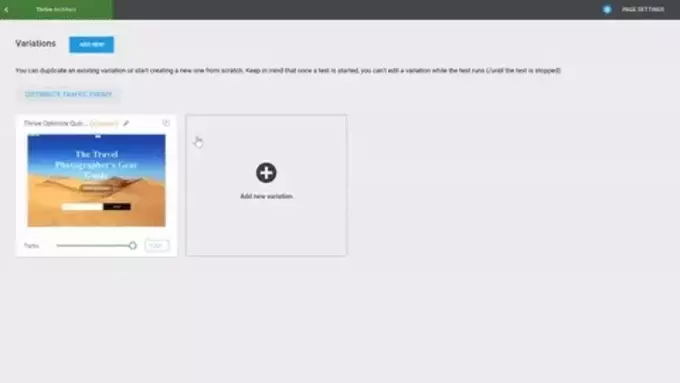
The best feature we found is that you don’t have to switch between tabs or windows to view the results of your experiments. If you’re using Google Optimize, then you’d have to jump back and forth between tabs to see the results.
Instead, Thrive Optimize shows a report inside your WordPress dashboard. You can quickly view which variant is converting the best. Besides that, you can create as many variations of a landing page for testing as you want. The plugin also picks a winner and shows the best variant.
Why We Choose Thrive Optimize: What makes it the best alternative in our experience is that, unlike Google Optimize, the plugin is beginner-friendly. There is no need to add code snippets to your site.
Pricing: Thrive Optimize is part of the Thrive Themes suite, which costs $299 per year and includes 9 other powerful conversion tools. You can also purchase the Thrive Optimize bundle for $199 / year.
To learn more, see our detailed Thrive Themes review.
2. OptinMonster
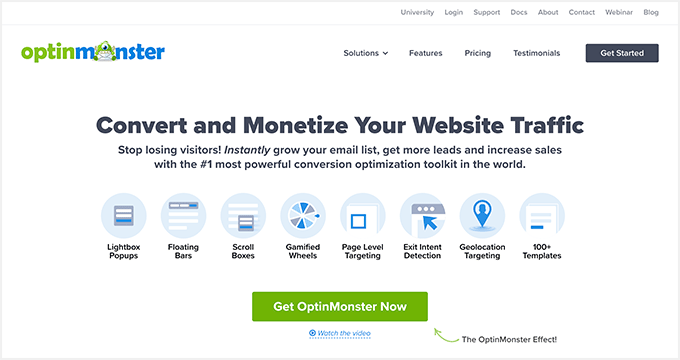
OptinMonster is the best WordPress popup plugin and lead generation software in the market. You can create campaigns like floating bars, welcome screen mats, and popups to grow your email list, increase conversions, and get more leads.
OptinMonster offers an A/B testing tool for testing different popup and modal campaigns. It’s a great Google Optimize alternative because it’s very easy to use. The drag-and-drop campaign builder allows you to customize and create different variants. At WPBeginner, we also use OptinMonster to run different campaigns and split-test them to improve conversions.
Once you’ve created a split test, OptinMonster will randomly show the variations to your visitors and pick a clear winner. You can then see in-depth stats about conversions inside your WordPress dashboard and find out which campaign performs the best.
Why We Choose OptinMonster: If you are trying to figure out which popup design will convert the best, then OptinMonster’s built-in A/B testing tool is a must-have for any website owner. It’s easy to use, and you can create multiple variants to experiment with.
Pricing: You will need the OptinMonster Plus or higher plan to use the A/B testing feature, with prices starting from $19 per month.
3. VWO Testing

VWO Testing is a popular A/B testing tool and a great alternative to Google Optimize. You get more features than Google Optimize, as it allows you to run multiple experiments on your website, products, apps, and server side.
It comes with a visual builder to change different elements on your webpage, like text, images, shapes, backgrounds, and more. After making the changes, you can run split tests and see which variant performs the best.
VWO Testing offers an AI-powered copywriting tool. This way, you can automatically select different headlines, CTA copies, and product descriptions to test.
It also lets you run tests based on user segments and behavior. For instance, you can select a target audience based on time spent on a page, scroll depth, exit intent, and when someone clicks on elements.
Why We Choose VWO: During our testing, VWO was one of the few Google Optimize alternatives that offered more features and allowed you to run experiences across different channels. It’s a powerful solution to have on your site.
Pricing: VWO offers a free plan that you can use for up to 50 thousand users per month. If you have more users, then you can upgrade to their premium plans.
4. FunnelKit

FunnelKit, formerly known as WooFunnels, is the best WordPress and WooCommerce sales funnel plugin. The plugin allows you to create funnels to generate leads, offer seamless checkouts, offer one-click upsells, and more.
FunnelKit is another Google Optimize alternative that comes with an A/B testing feature, especially for WooCommerce. You can split-test your product prices, page layouts, messages, designs, and funnels without editing code.
Besides that, FunnelKit also offers other features. For example, it offers FunnelKit Automations, which allows you to set up automated emails and SMS campaigns.
Why We Choose FunnelKit: In our experience, the plugin is beginner-friendly and helps you set up experiments within minutes. You can test headings, images, prices, product descriptions, and every other component on a page. FunnelKit also helps declare a winner once there’s enough data to see which funnel converts the best.
Pricing: FunnelKit offers multiple pricing plans. To use the A/B Testing feature, you’ll need the Plus plan. It will cost you $179.50 per year.
5. UserFeedback
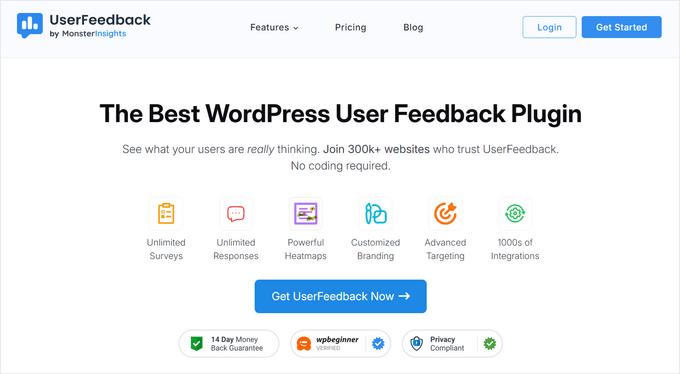
UserFeedback is a powerful plugin that lets you collect authentic feedback from your website visitors in real time. Unlike traditional analytics, this direct feedback reveals exactly what your visitors are thinking and what they want from your site.
For example, you can ask users what information is missing from your site, why they didn’t purchase a product, what type of content they want to see, and more. This allows you to better understand the intent and make website improvements that matter to your audience.
UserFeedback is super easy to use, and it comes with pre-made templates to help you quickly create popup feedback surveys.
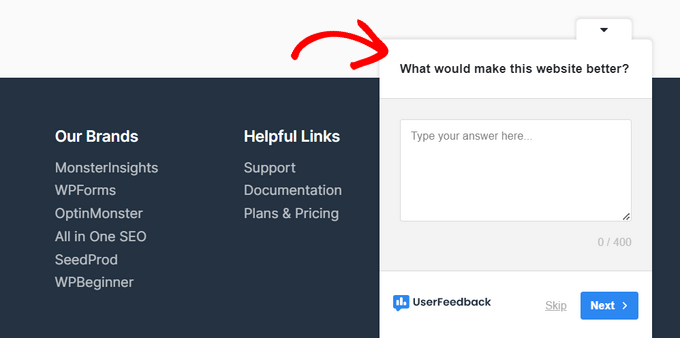
You can ask free-form questions, multiple choice questions, and even collect emails and star ratings. It comes with features like built-in reporting, page-level targeting, Google Analytics and MonsterInsights integrations, and more.
Plus, UserFeedback recently added heatmap tracking that shows you exactly where visitors click, scroll, and focus their attention on your pages. This visual data complements the survey feedback by showing you how people actually interact with your site.
Why We Choose UserFeedback: The combination of visitor feedback and heatmap tracking gives you the best of both worlds. You can see exactly how visitors interact with your pages while also getting their direct feedback, making it easier to spot and fix any issues on your site.
Pricing: UserFeedback starts at $49.50 per year. To access the heatmap feature, you need the Elite plan, which costs $149.50 per year. There’s also a free version of UserFeedback that you can use to get started.
6. Convert.com
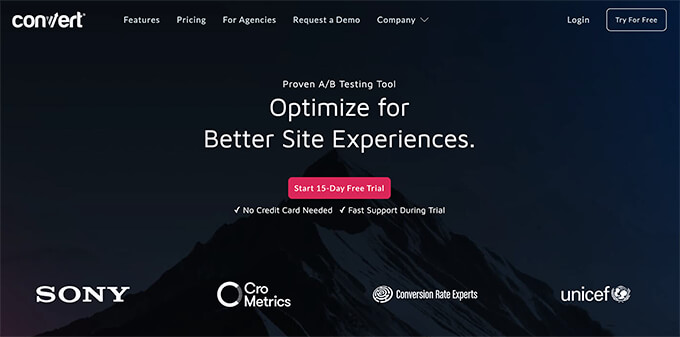
Convert.com is a proven A/B testing tool to help you boost conversions. It provides a fast & flicker-free A/B testing experience and is known for its speed.
It is a perfect Google Optimize alternative because it gives you access to all the features you’re accustomed to with Google Optimize and then some more.
Convert also lets you seamlessly integrate your tests with Google Analytics as well as other tools like Hotjar, Heap, Segment, HubSpot, and more.
Their onboarding is a bit slow, but once you are up and running, you can create unlimited tests and quickly deploy changes.
Why We Choose Convert.com: What makes Covert.com different is its speed. It ensures fast load times using flicker-free testing and Akamai CDNs. You get accurate results as there is no delay in showing different variants of your experiment to users.
Pricing: Convert.com prices start from $99 per month, and you get a 15-day free trial.
7. Crazy Egg

Crazy Egg is a popular heatmap tool. You can use heatmaps to see how users behave on your website, where they click, and how they move the mouse cursor and scroll through pages.
Crazy Egg offers an A/B testing tool that you can use to run experiments on your website and boost conversions. What makes it a great Google Optimize alternative is the features it offers along with A/B testing.
You get heatmaps, recordings of visitors using your website, error tracking, surveys, and traffic analytics. Plus, you can configure it without editing code, which isn’t possible if you’re Google Optimize.
Crazy Egg offers a multivariate engine where all you need to do is choose the elements you want to test and add your ideas. The engine then does the heavy lifting and conducts the test for you.
The best part is that it is easily integrated with website builders, including WordPress, Shopify, Squarespace, Wix, and more.
Why We Choose Crazy Egg: We recommend Crazy Egg as an alternative to Google Optimize because of the additional features it offers. You get heatmaps, recordings, error tracking, and much more.
Pricing: Crazy Egg offers different pricing plans starting from $29 per month. You get unlimited A/B tests in each pricing plan, and there is also a 30-day free trial to get started.
8. Adobe Target

Adobe Target is an enterprise-level solution to run split tests on their website and is part of Adobe Marketing Cloud. It is more powerful than Google Optimize and offers an omnichannel approach to the A/B test.
What this means is that instead of running isolated experiments, Adobe Target lets you run tests on every channel. This way, you get to see how users behave with different variants coming from other channels, like social media, organic traffic, paid search, and more.
The software is easy to use and set up. Plus, its AI-powered automation helps you test multiple experiences and then personalize them for each visitor.
On the downside, Adobe Analytics is only available for users with Adobe Analytics. If you’re looking for a complete marketing solution with an A/B testing feature, then you can use Thrive Optimize instead.
Why We Choose Adobe Analytics: It is a great solution for enterprises and large corporations that are already using Adobe solutions. It offers a powerful A/B testing solution that runs experiments using an omnichannel approach.
Pricing: You will need to request a quote and get Adobe Target pricing according to your business needs.
9. Optimizely
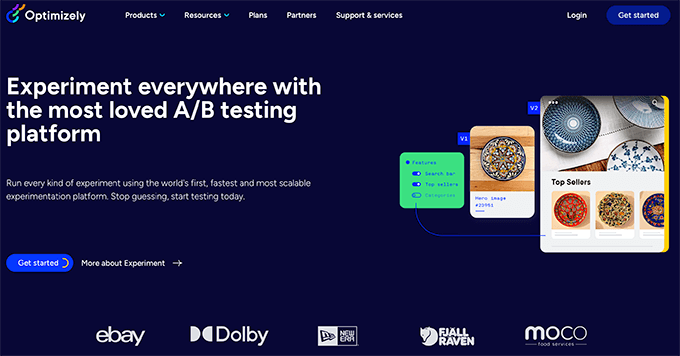
Optimizely is one of the most popular Google Optimize alternatives on the market. Their digital experience platform allows you to create every kind of A/B testing experiment for your website.
You can use their visual editor along with advanced targeting features to optimize your A/B testing campaigns. Optimizely works on all website platforms and is a popular choice for many large brands.
We have used Optimizely in the past when they had a free plan, and it’s an extremely powerful tool for what it does. However, the prices are no longer small business friendly.
Why We Choose Optimizely: In our experience, Optimizely is perfect for all types of websites. Be it a blog website, online store, agency site, membership site, or more, the tools will help you run split tests with ease.
Pricing: Optimizely does not reveal its prices anymore and requires that you submit a form to request a quote.
Bonus: Kameleoon

Kameleoon is the last Google Optimize alternative on our list. It offers powerful solutions and lets you conduct different types of experiments.
For starters, you can run web experiments and A/B test your website and mobile apps. You can assign a business goal to your tests and see which variant is increasing conversions, retention, or engagement.
Kameleoon also offers A/B testing features to advanced users and developers. You can run server-side experiments to improve your product. It easily works in different development languages and frameworks, like PHP, Java, Ruby, Flutter, and more.
Besides that, it offers AI-power personalization. You can provide unique experiences to each visitor, target different segments for testing, and comply with privacy laws like GDPR and CCPA.
Why We Choose Kameleoon: If you are looking for a Google Optimize alternative that works on the server side of things, then this is the best solution. It supports multiple programming languages and helps developers run A/B tests.
Pricing: You will need to request a demo and get a quote for Kameleoon pricing.
Which Is the Best Google Optimize Alternative? (Expert Pick)
The best Google Optimize alternatives are Thrive Optimize, OptinMonster, VWO Testing, and FunnelKit.
If you are looking for a WordPress A/B testing tool, then Thrive Optimize is our first pick. It gives you all the powerful features you need, and it’s very affordable. Since it’s part of the Thrive Suite, you also get other solutions like a quiz builder, popup form builder, WordPress page builder, and more.
On the other hand, OptinMonster is another great solution to boost conversions on your site and run split tests. You can A/B test different campaigns, create variants, and see which one performs the best.
If you are looking for an all-around SaaS alternative for Google Optimize that works on all platforms, then we recommend using VWO Testing. They have a generous free plan that should work for most small business owners.
And if you are an eCommerce store owner looking for the best Google Optimize alternative for WooCommerce, then we recommend using FunnelKit. They have deep integration with WooCommerce and allow you to customize every step of the funnel, including adding custom 1-click upsells, order bumps, and more to help boost your average order value.
FAQs About Google Optimize Alternatives
Here are some frequently asked questions about Google Optimize alternatives that many users ask.
1. Is Google Optimize Free?
Google Optimize was a free tool offered by Google that let you run experiments on your website. It let you A/B test landing pages and make changes to see which variant performed the best.
2. What is replacing Google Optimize?
Google Optimize was replaced with a Google Analytics 4 integration with popular A/B testing.
3. Why did Google sunset Optimize?
Google Optimize and Optimize 360 didn’t have many features and services that many users requested for experimentation testing. That’s why Google sunset Optimize instead of investing in offering the most effective solutions and integrations for its customers.
4. Can I still use Google Optimize?
No, Google Optimize is no longer available for use. Google sunset it in September 2023.
Video List
If you’d rather not read our reviews, check out our video list of the best Google Optimize alternatives:
We hope this article helped you find the best Google Optimize alternative. You may also want to see our guide on how to increase landing page conversions or how to improve the organic click-through rate.
If you liked this article, then please subscribe to our YouTube Channel for WordPress video tutorials. You can also find us on Twitter and Facebook.





Jiří Vaněk
These optimization tools for websites are great and practically a necessity today. I primarily use OptinMonster and I can’t praise this plugin enough. I have used A/B testing several times, and it has given me great feedback on what works and what doesn’t. Thanks to this, I was able to tailor campaigns precisely to the behavior of my users, which is invaluable. As always, a great list of tools.
Moinuddin Waheed
having optimizing tools for websites is a must for A/B testing and Google optimising tool has been since long time catering this need.
Thanks for the list of all the alternatives for Google optimize tool.
it will help explore these tools to see which can be the best replacement of the Google optimize tool.
WPBeginner Support
Glad we could share some alternatives that you can use
Admin